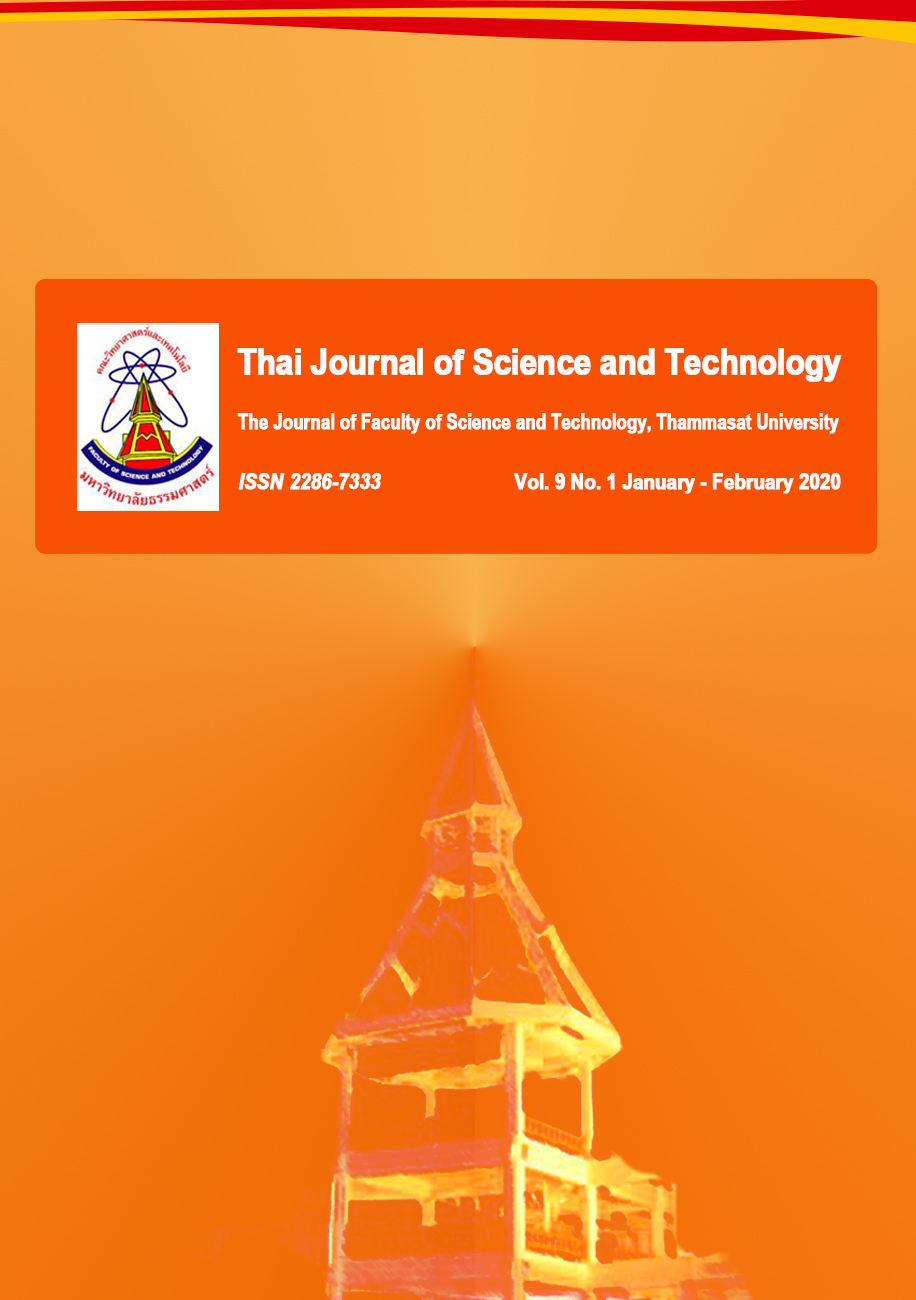การให้แสงเสริมจากหลอด LED แก่กระชายดำที่ปลูกในโรงเรือน
Main Article Content
Abstract
Study on using supplemental LED light for black ginger cultivation under greenhouse condition. Completely randomized design (CRD) with 4 treatments, i.e. 2 white light LEDs (2W), LED white: blue light ratio 2: 1 (2W1B) and LED white: blue light ratio 1: 2 (1W2B) compared with planting non-LED, supplemental light for 3 hours before 6 a.m. and 3 hours after 6 p.m. The plant growth, active compounds, antioxidant activity, anthocyanin, total phenolic compounds and 5,7-dimethoxyflavone were recorded. The results revealed that growth parameters, i.e. the plant height, number of clump, leaf greenness, fresh and dry weight of rhizome, and percentage of crude extract were not significantly different. The data of active compounds showed the best results of total phenolic compounds and 5,7-dimethoxyflavone content at non-LED light, supplemented with the mixture of white light tube: blue light tubes (2: 1) and (1: 2), anthocyanin highest at non-LED light, supplemented with 2 white light LEDs (2W) and the mixture of white light tube: blue light tubes (1: 2).
Article Details
บทความที่ได้รับการตีพิมพ์เป็นลิขสิทธิ์ของคณะวิทยาศาสตร์และเทคโนโลยี มหาวิทยาลัยธรรมศาสตร์ ข้อความที่ปรากฏในแต่ละเรื่องของวารสารเล่มนี้เป็นเพียงความเห็นส่วนตัวของผู้เขียน ไม่มีความเกี่ยวข้องกับคณะวิทยาศาสตร์และเทคโนโลยี หรือคณาจารย์ท่านอื่นในมหาวิทยาลัยธรรมศาสตร์ ผู้เขียนต้องยืนยันว่าความรับผิดชอบต่อทุกข้อความที่นำเสนอไว้ในบทความของตน หากมีข้อผิดพลาดหรือความไม่ถูกต้องใด ๆ
References
ณพัฐอร บัวฉุน และปิยะพัฒน์ สุนทรศาสตร์, 2558, การพัฒนาโลชั่นจากสารสกัดหยาบชะเอมไทยที่มีฤทธิ์ต้านอนุมูลอิสระ, ว.วิจัยและพัฒนา วไลยอลงกรณ์ ในพระบรมราชูปถัมภ์ 10(2): 97-106.
สมนึก บุญสุภา, 2560, กระชายดำ : สมุนไพรเพื่อบุรุษ, น. 185-221, ใน วีณา นุกูลการ และชุติมา เพ็ชรประยูร, สมุนไพร Champion Product, สำนักพิมพ์บุญศิริการพิมพ์, กรุงเทพฯ.
เสริมสกุล พจนการุณ และเชวง แก้วรักษ์, 2548, การผลิต ปัญหาการผลิต และการตลาดกระชายดำของเกษตรกรผู้ปลูกกระชายดำ, น. 25-30, ใน ผลงานฉบับเต็มของนายเสริมสกุล พจนการุณ, สำนักวิจัยและพัฒนาการเกษตรเขตที่ 3, ขอนแก่น.
เสริมสกุล พจนการุณ, สุกัญญา วงศ์พรชัย และศิริพร พจนการุณ, 2551, อิทธิพลของละติจูดและความสูงของพื้นที่ที่ปลูกที่แตกต่างกันต่อองค์ประกอบทางเคมีด้านปริมาณเทอร์พีนอยด์ ฟีนอลิกทั้งหมด และความสามารถกำจัดอนุมูลอิสระของเหง้ากระชายดำ, ว.วิทยาศาสตร์เกษตร 39(3)(พิเศษ): 341-344.
สุวิทย์ วรรณศรี, 2554, เทคนิคการเพิ่มผลผลิตว่านกระชายดำ, รายงานวิจัย, มหาวิทยาลัยราชภัฏเพชรบูรณ์, เพชรบูรณ์.
อรัญญา ศรีบุศราคัม, 2558, จุลสารสมุนไพร, สำนักพิมพ์คณะรัฐมนตรีและราชกิจจานุ เบกษา,กรุงเทพฯ.
Ang, L.F., Mun, F.Y., Yvonne, T.T.F., Peh, K.K. and Yusrida, D., 2014, HPLC method for simultaneous quantitative detection of quercetin and curcuminoids in traditional Chinese medicines, J. Pharmacopuncture 17(4): 36-49.
Gao, X., Maria, O., Niklas, J., Lars, B. and Viktor, T., 2000, Changes in antioxidant effects and their relationship to phytonutrients in fruits of sea buckthorn (Hippophae rhamnoides L.) during maturation, J. Agric. Food Chem. 48: 1485-1490.
Gubler, F., Trijntje, H., Peter, W. and John, J., 2008, Regulation of dormancy in barley by blue light and after-ripening: Effects on abscisic and gibberellin metabolism, Plant Physiol. 147: 886-896.
Hogewoning, S.W.H., Govert, T., Hans, M., Hendrink, P., Wim V.I. and Jeremy, H., 2010, Blue light dose-responses of leaf photosynthesis, morphology, and chemical composition of Cucumis sativus grown under different combinations of red and blue light, J. Exp. Bot. 61: 3107-3117.
Horigome, S., Yoshida, I., Tsuda, A., Harada, T., Yamaguchi, A. and Yamazaki, K., 2014, Identification and evaluation of anti-inflammatory compounds from Kaempferia parviflora, Biosci. Biotechnol. Biochem. 78: 851-860.
Karppinen, K., Pinja, T., Hely, H. and Laura, J., 2018, Abscisic acid regulates anthocyanin biosynthesis and gene expression associated with cell wall modification in ripening bilberry (Vaccinium myrtillus L.) fruits, Front. Plant Sci. 9: 1-17.
Kondo, S., Tomiyama, H., Rodyoung, A., Okawa, K., Ohara, H., Sugaya, S., Terahara, N. and Hirai, N., 2014. Abscisic acid metabolism and anthocyanin synthesis in grape skin are affected by light emitting diode (LED) irradiation at night, J. Plant Physiol. 171: 823-829.
Mao, C., Songchong, L., Bo, L., Bin, Z., Jiabin, S., Jianmei, H., Liqiong, L., Dandan, X., Xu, C. and Feng, M., 2017, A rice NAC transcription factor promotes leaf senescence via ABA biosynthesis, Plant Physiol. 174: 1747-1763.
Masuda, J.I., Toshihiro, U., Yukio, O. and Hiroshi, O., 2006, Short photoperiod induces dormancy in lotus (Nelumbo nucifera), Ann. Bot. 97: 39-45.
Mizukami, H., Kaomi, T. and Hiromu, O., 1988, Anthocyanin production in callus cultures of roselle (Hibiscus sabdariffa L.), Plant Cell Rep. 7: 553-556.
Palmer, N.A., Aaron, J.S., Erin, D.S., Christian, M.T., Paul, T., Soundararajan, M., Marty, S., Rebecca, C., Scott, E.S., Serge, J.E., Robert, B.M. and Gautam, S., 2017, Seasonal below-ground metabolism in switchgrass,
Plant J. 92: 1059-1075.
Payet B., Alain, S.C.S. and Smadja, J., 2005, Assessment of antioxidant activity of cane brown sugars by ABTS and DPPH radical scavenging assays: determination of their polyphenolic and volatile constituents, J. Agric. Food Chem. 53: 10074-10079.
Re, R., Pellegrini, N., Proteggente, A., Pannala, A., Yang M. and Rice-evans, C., 1999, Antioxidant activity applying an improved ABTS radical cation decolorization assay, Free Rad. Biol. Med. 26: 1231-1237.
Rujjanawate, C., Kanjanapothi, D., Amornlerd pison, D. and Pojanagaroon, S., 2005, Anti-gastric ulcer effect of Kaempferia parviflora, J. Ethnopharm. 102: 120-122.
Sirirugsa, P., 1991, Taxonomy of the genus kaempferia (Zingiberaceae) in Thailand, Thai Forest Bull. (Bot.) 19: 1-15.
Tewtrakul, S. and Subhadhirasakul, S., 2007, Anti-allergic activity of some selected plants in the Zingiberaceae family, J. Ethnopharm. 109: 535-538.
Wattanasri, P., Ngawhirunpat, T., Rojanarata, T., Nattapulwat, N. and Opanasopit, P., 2016, Development of Kaempferia parviflora extract-loaded microemulsions for skin permeation enhancement, Thai J. Pharm. Sci. 40: 37-40.
Wattanapitayakul, S.K., Chularojmontri, L., Herunsalee, A., Charuchongkolwongse, S., Chansuvanich, N., 2008, Vasorelaxation and antispasmodic effects of Kaempferia parviflora ethanolic extract in isolated rat organ studies, Fitoterapia 79: 214-216.


